-
Paper Information
- Next Paper
- Paper Submission
-
Journal Information
- About This Journal
- Editorial Board
- Current Issue
- Archive
- Author Guidelines
- Contact Us
Management
p-ISSN: 2162-9374 e-ISSN: 2162-8416
2016; 6(5): 137-145
doi:10.5923/j.mm.20160605.01

Entrepreneurship Development: Reflections on Organisational Challenges that Hinder Their Growth
Clement Mwaanga, Leah Chewe
Business School, Mulungushi University, Kabwe, Zambia
Correspondence to: Clement Mwaanga, Business School, Mulungushi University, Kabwe, Zambia.
| Email: |  |
Copyright © 2016 Scientific & Academic Publishing. All Rights Reserved.
This work is licensed under the Creative Commons Attribution International License (CC BY).
http://creativecommons.org/licenses/by/4.0/

The main objective of this study was to identify organizational factors that hinder the growth of entrepreneurs. In order to achieve this objective, we developed a survey instrument and data was gathered by sampling entrepreneurs in Solwezi town in Zambia. Therefore we found that most of the entrepreneurs were already established having been in existence for over three and half years. The major challenges which they were facing (and contributing to their stagnation) were lack of capital, inaccessibility to credit, and lack of appropriate infrastructure, lack of market information and connections and difficulties in accessing technology, among others. The study also revealed that educational levels of most of the entrepreneurs had an impact on their growth. Finally we draw conclusion and suggestion for entrepreneurs, researchers and policy makers.
Keywords: Small Businesses, Business failure, Enterprise development, Entrepreneurship
Cite this paper: Clement Mwaanga, Leah Chewe, Entrepreneurship Development: Reflections on Organisational Challenges that Hinder Their Growth, Management, Vol. 6 No. 5, 2016, pp. 137-145. doi: 10.5923/j.mm.20160605.01.
Article Outline
1. Introduction
- Over the last decade, research into enterprise development has grown because of the massive failure of a number of industrial and economic reforms which has stimulated great response from the private sectors, hence the need to supplement liberalisation measures with pro-active policies to attain the desired goal (Bhacttacharya, 2002). Entrepreneurship has been the backbone of the Zambian economy since the ardent of privatization, as many people no longer depend on the government for them to survive except in few situations. Small and medium enterprises (SMEs) play a major role in economic development in every country, including in African countries. Literature on enterprise development suggests that in both advanced economies and developing countries SMEs contribute on average 60 percent of total formal employment in the manufacturing sector (Bhacttacharya, 2002). Therefore, for African economies, the contribution of the SME sector to job opportunities is even more important and accounts for about three-quarters of total employment in manufacturing. The Zambia Development Agency (ZDA) has put in place a number of programmes to sustain the small scale businesses (ZDA, 2013). These efforts have been categorised into three development pillars namely, capacity, access and operating environment. Despite these efforts most of the entrepreneurs are operating in a downward spiral with most of them closing down their businesses and getting back to their old ways of doing business (ZDA, 2013). Those that have continued seem not to show any significant improvement in their profit margins. According to ILO (2005), starting a business is a risky venture and warns that the chances of small-business owners making it past the five-year mark are very slim. Recent research into small-business development has also shown that the rate of failure of entrepreneurs in developing countries is higher than in the developed world (Marlow, 2009). Following the identification of the many challenges faced by entrepreneurs in Zambia, the government had provided a number of policies to enhance the growth of entrepreneurs (ZDA, 2013). However, despite such initiatives, the growth rate of entrepreneurs in many parts of the country, Solwezi inclusive, was low.It was from this background that this study was undertaken to ascertain internal or organisational factors that hinder the growth entrepreneurs and also to establish whether their level of education has influence on their growth in the competitive business environment.
2. Literature Review
- In this review, we looked at the relevant literature based on the factors that impacted the growth of entrepreneurs. Literature review was discussed according to themes based on the study objectives and these were: the level or stage of entrepreneurial development, relationship between entrepreneur education/training and growth, challenges faced by entrepreneur in their pursuit for growth and what government (and other stakeholder) could do to help entrepreneurs overcome these challenges. The literature depicted both Zambian, African and Western point of view.
2.1. Organisational Factors
- There has been a number of research works carried out and published concerning organisational factors which hinders entrepreneur growth in rural district such as Solwezi. However various scholars and researchers have written from different perspective on the factors which impact the growth of entrepreneurs. Therefore, the literature review regarding the organisation factors hindering entrepreneurial growth can be categorised on the basis of those factors.Stages of Entrepreneurial DevelopmentEntrepreneurship development stages have been identified as one of the factors hindering their growth. Research has revealed that nascent entrepreneurs or entrepreneurs who were in their early stage of development such as new business owners (or those running a certain business for the first time) were likely to fail to move from that level to the next. According to the GEM (2013), activities of already established businesses were high and as such the rate of growth for new and nascent (potential) entrepreneurship could not match. This was partly because established entrepreneurial already had public support whereas nascent entrepreneurs could fail to develop simply because despite the brilliant ideas, most are not too decided as to which possibilities to pursue, they lacked business plans as well as effort to envision the desirable future and to try visualise its reality (Davidsson, 2006; Dollinger, 2008).It is interesting to associate the above levels or stages with Sugars’ (2008) levels of entrepreneurial development. As with most things in life, there are so many different levels to 'being in business’ and Sugars identified five different types or levels of entrepreneurial mind-sets, patterns of thinking, and belief systems. According to Sugars (2008) the basic level starts from that of being an employee through to that of a true entrepreneur which is the fifth and last level of entrepreneurial development. The employee entrepreneur who lacked security would not be in a position to relinquish the job and pursue the autonomy which comes with self-employment; such an employee entrepreneur would not grow because s/he could not do without an employer. At the other end of the continuum, the true entrepreneur would learn new things every step of the way and would evolve through various stage of entrepreneurial accomplishment. Such entrepreneurs would experiences a paradigm shift that involves the idealisation (imagination), visualisation (picture the ideal as a reality), verbalisation (putting into words the dream and talk as if it was happening) and materialisation (things falling into place and ideas becoming real). It is worth noting that the levels or stage of entrepreneurs helps distinguish growing entrepreneurs from those who do not and helps identify characteristics or traits that are commons to entrepreneurs with a propensity to grow such as confidence, sense of ownership, motivation and ambition, not afraid to take risks and optimistic among others. Education levels of entrepreneursEducation or training is considered as a very important cognitive factor for the development of entrepreneurs. It is the key constituent of human capital needed to run or manage a business. Nkoniki (2010) in his study on factors limiting the success and/or growth of small businesses, pointed out that educated entrepreneurs could discharge their entrepreneurial responsibilities effectively as they showed more promise result of how their businesses were doing, could take and manage risks more easily and had access to information regarding entrepreneurial activities. Another study by Sather (2012) on small scale aquaculture in rural Zambia indicated that lack of business knowledge posed a serious hindrance to sustainable growth as local entrepreneurs were not equipped rationally to provide the momentum and motivation needed for the business to remain successful. As could be expected, lack of education or training not only affect the efficiency of entrepreneurs but also affect the opening of new lines of businesses, restrains access to information as well as inhibits business knowledge such as keeping accounts or estimating costs and profits which subsequently affect operations. Therefore education or training is a key issue to entrepreneurs’ growth as it guides the rate of development and also guides which science, technology and management style would be used. Thus, lack of basic education, knowledge, training (and experience) seriously affected the entrepreneurial growth as it was a barrier to expansion of business in all sectors such as processing, manufacturing or service (Nawaz, 2009). Entrepreneurs’ experience The characteristics of management know-how of an entrepreneur were considered as important factors in the process of firm growth. Management know-how was the possible outcome of many factors like having experience of paid-employment in a similar business, or of having previous management experience being owner of some other business.Papadaki et al., (2000), pointed out that individuals from families owning business were more inclined to start and ‘grow’ entrepreneurial ventures by developing knowledge of how to run businesses. The study suggested that belonging to an entrepreneurial family augmented the probability of survival. Other literatures stated that related experience contributed positively to enhancing self-confidence among entrepreneurs and lead them to venture success (Delmar and Shane 2006). This was because it was obvious that such entrepreneurs would use past experiences to help them in both managing new venture and took advantage of an already established network of customers, employees, investors and suppliers playing a crucial role for the success of a new business.Lack of association with professional advisors like bankers, accountants, business associates, customers and suppliers could be a hindrance to entrepreneurial growth. This is because such associations could help small business owners gain knowledge and access to information networks leading to develop more formal joint venture and alliances. Partnerships and alliances could help both in spreading risks and sharing costs along with opening of new markets and development of new services, products and processes. Partnered business ventures also provided psychological support in decision making and other major problems faced by the owners (Perren, 2000; OECD, 2000).
2.2. Challenges Faced by Entrepreneurs in Their Pursuit for Growth
- Basically, a firm’s growth was limited to its resources. Resources could determine the industry the firm would enter, its growth processes and subsequently the levels of profit it could attain. For example, insufficient or lack of access to capital, lack of proper infrastructure, lack of market information and connection, labour shortages and poor management posed a challenge to entrepreneurs in their pursuit for growth (McConnell, 2011). Inadequate or Lack of Access to CapitalAll business ventures regardless of size require finances from inception and throughout their life cycles. The amount invested could greatly influence the size of the undertaking, which in turn could determine the very survival of an enterprise if other factors were held constant. The entrepreneur could require seed capital to start the business, to operate and manage the business enterprise.Studies by Kuzilwa (2005) and Nkoniki (2010) pointed to finance capital as one of the key constraints to small enterprise growth. Small enterprise owners could not easily access finance to expand business and they were usually faced with problems of credit restrictions and need for collateral among other numerous conditions. This meant that when pursuing growth, entrepreneurs did not have sufficient financial resources to enable them achieve the intended target.In a study by Mbugua et al (2013) on factors affecting growth of micro and small scale enterprises, it was noted that unavailability or lack of information about alternative sources of finances and inability of entrepreneurs to evaluate financing option were some of the major problems which entrepreneurs faced in their pursuit for growth. In essence, lack of information about alternative sources of finance was one of the constraining factors or hindrances to small enterprise growth.Lack of Infrastructural FacilitiesIt is a universal belief that certain basic infrastructural facilities aid the development of the mind and body and assist productivity in any environment. For a business organisation, some of these facilities could be identified as appropriate or good business premises, access to information and communication technology and other tools of trade. A case where these were lacking growth will be adversely affected.Safdar and Siddiqi (2011) carried out a research on the role played by technological infrastructure in entrepreneurial growth. Their findings revealed that small entrepreneurs could carry out a large number of technological innovations based on their unique know how as well as access to technological infrastructure. However, the research findings revealed that most small entrepreneurs lacked the current ability and their future potential to access (and utilize) firm-specific technology to resolve technical problems and to expand the technical functioning of its production processes along with its finished products. Because of their smallness these enterprises could end up using cheap technology which was usually not top of the range. This could result into high costs of production and un-competitiveness and subsequently failure to grow. Most entrepreneurs do not know how to operate computers or continuously upgrade their equipment or system (Dabson 2001; Malecki 2001). Lack of Market Connection and InformationGenerally, entrepreneurs faced stiff competition among themselves and as such any business could require marketing strategies for it to survive or grow (Kotler and Armstrong 2003). Effective marketing was vital to the future growth of any business and it was often stated that ‘if anyone wanted to make the business better, then one needed to get better at marketing’.IFAD (2011) revealed that many entrepreneurs faced a combined lack of market connection and exposure. These resulted in limited capacity to identify and take advantage of market opportunities offered by the growing local economies and globalization. Furthermore, because of their lack of market connections, most entrepreneurs could not afford to develop the critical mass of functions that were essential to access and secure market shares.Labour Shortages Literature concerning determinants of firm growth considers human capital as one of the most important factors effecting small business growth. Many studies have pointed to lack of appropriate skills as the most significant constraint faced by small business in their pursuit for growth. At the formation stage a small owner is able to run a business but as it intends to grow, more and specialised labour demand would arise. These demands were in form of operational requirements like production, sales and finance, among others. According to scholars, at the firm level, the experience, skill and knowledge of the total employees contribute more prominently to growth as compared to the entrepreneur alone (Wiklund et al., 2007).Poor Management As mentioned earlier, management contributed to the success or failure of the firm. According to scholars, scarcity of management capacity (or poor management) was the most important limiting factor (Dollinger, 2008). There were two demands on managerial capacity: to run the firm at its current size, and to expand and grow. When it came to expansion, current managers would recruit new managers to increase the growth potential of the venture. However, these new managers needed to be trained and integrated into the firm’s current activities, which would take time away from existing managers. While incorporating these new managers, the firm’s growth could be slowed.Poor implementation of internal controls designed and instituted by management such as separation of the functions of authorizing transactions, recording transactions, and maintaining custody of certain types of assets posed a challenge to growth. As a result of this failure to implement and follow proper control procedures, a significant portion of the company’s most liquid assets could be susceptible to being stolen by employees of the company and concealed from management. Consequently, this was challenge to growth of many entrepreneurs as they would have to mobilise lost resources again (Godfrey et al, 2011).
2.3. The role of Government and Other stakeholders
- Several studies have been conducted with regards to the role of government policies in the development of entrepreneurship generally (Friedman. 2011; Minnit, 2008; Pals, 2006). Their various contributions have been contradictory as well as supporting. For example while some researchers are in support of government policies in encouraging entrepreneurship, others are on the contrary. A case in point was Friedman (2011) argued that perceived government effectiveness was significantly negatively related to entrepreneurship on a national level. On the other hand, Minnit (2008) observed that government policy add vigorously to the development of an institutional setting that encourages productive entrepreneurship. He added that the relationship between policy and entrepreneurial activity varies across countries.Further, a research conducted by McConnell et al (2011) to find out how government could help stimulate growth in entrepreneurs revealed that instead of protectionism, support could be in the context of liberalization, (which sought to replace protection with competitiveness) to infuse more vitality and growth to entrepreneurships in the face of foreign competition and open market. The report further indicated that supportive measures could concentrate on improving infrastructure, technology and quality. In a nutshell, as was cited by Ducker (1986), government and government related policies had been important factors affecting business growth or failure. In view of these findings, the National League of Cities of the US conducted research in 2010 and 2011 to help identify key areas for action. The report revealed that in order to support entrepreneurs, governments should first examine the policies and actions that lie squarely within their powers. This could include policies on leadership, communication strategies (that create avenues for local businesses to engage with government) and an efficient regulatory environment.On the other hand, the research indicated that small business development stakeholders could create programs that could target supporting businesses and entrepreneurs within their various stages of development. For example, support programs could help examine the feasibility of a business idea and provide the resources to legally become an entity in the community; provide mentoring services and activities focused on improving business plans and building local base; provision of targeted resources to help businesses grow; provide research facilities to help them expand into external markets and avenues to network with peers and mentors on common growth issues as well as assistance with expansion financing and new legal and regulatory commitments.Having highlighted what had been done by other scholars’ world over, there was need to conduct an investigation especially in the Zambian context and in this case a rural district which was rapidly transforming. Those investigations should at least provide a framework for organisational strategies so as to enhance entrepreneurial growth.
3. Methodology
- This research paper is the product of the dissertation which was submitted to Mulungushi University in the school of business for the partial fulfilment of the award of the Bachelor of Commerce degree. We collected primary data from the combination of survey questionnaires and semi-structured interviews of key informants. Survey questionnaires were used to enable individual organisational factors of entrepreneurs businesses to be examined and semi-structured interviews enabled as to analysis effectively the responses from the questionnaires. Triangulation method was used to add validity and diversify the research process. This also helped to leverage on the strengths of both methods (quantitative and qualitative) to complement their weaknesses (Saunders et al, 2003). According to Remenyi et al (1998), triangulation is useful in all cases and it helps the study to ensure that “the data are telling you what you think they are telling you.”As a sampling technique, we adopted purposive sampling techniques to generate the primary data because it involves choosing respondents whose views are relevant, important and of value to the research (Remenyi et al, 1998). This approach was appropriate for this study because of lack reliable data which makes it difficult to study entrepreneurs as observed by Watson and Everett (1996).For the sample size, Saunders et al (2003) argued that for statistical analysis, a minimum number of thirty (30) provides a useful rule of thumb. However, for this study we chose a sample size of 150. We administered 145 questionnaires and conducted 5 semi-structured interviews with key informants on a one-to-one, face- to- face basis. Data processing was performed using excel. The study was conducted for the period of eight (8) months.Out of 145 questionnaires distributed, only 133 were collected which represents about 91.7% respondents. This percentage (91.7%) of the sample was sufficient and significant for analysing and identifying key organisational factors that hinder the growth of entrepreneurs.
4. Research Findings
- The profile of respondents showed that 87% of the respondents were male and 13% female as shown below in figure 4.1.
 | Figure 4.1. Gender of Respondents |
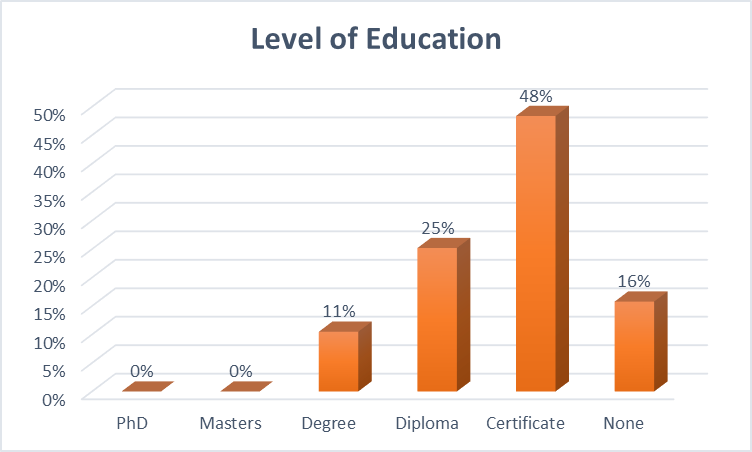 | Figure 4.2. Level of Education of Respondents |
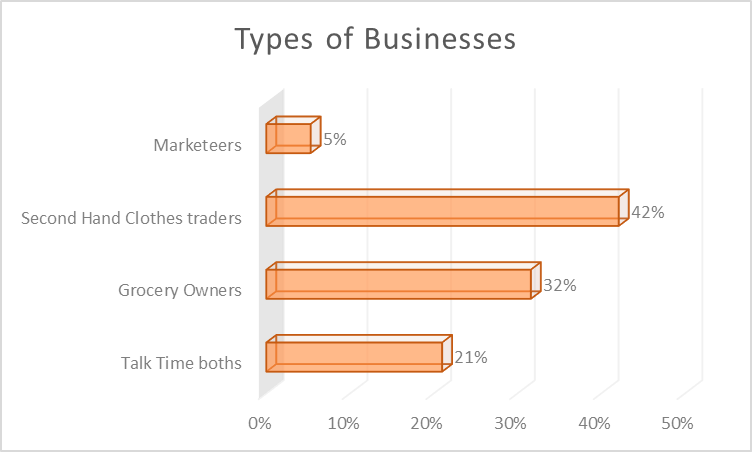 | Figure 4.3. Types of Businesses |
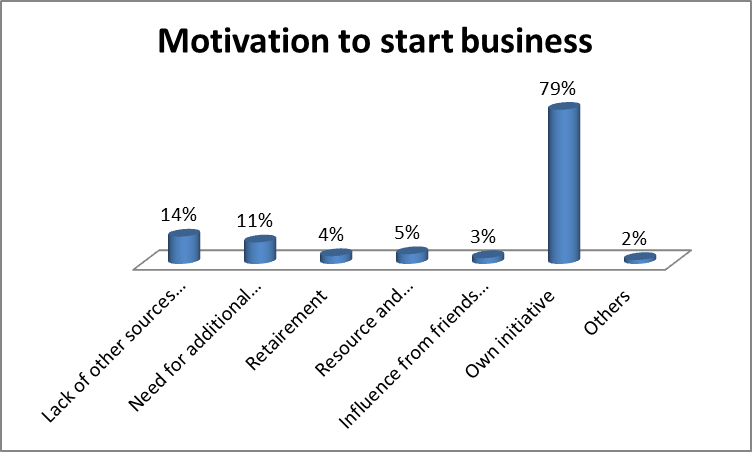 | Figure 4.4. Motivation to do Business |
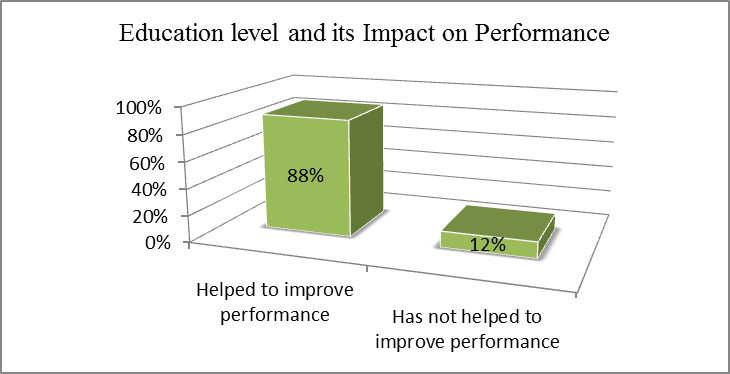 | Figure 4.5. The impact of education on performance |
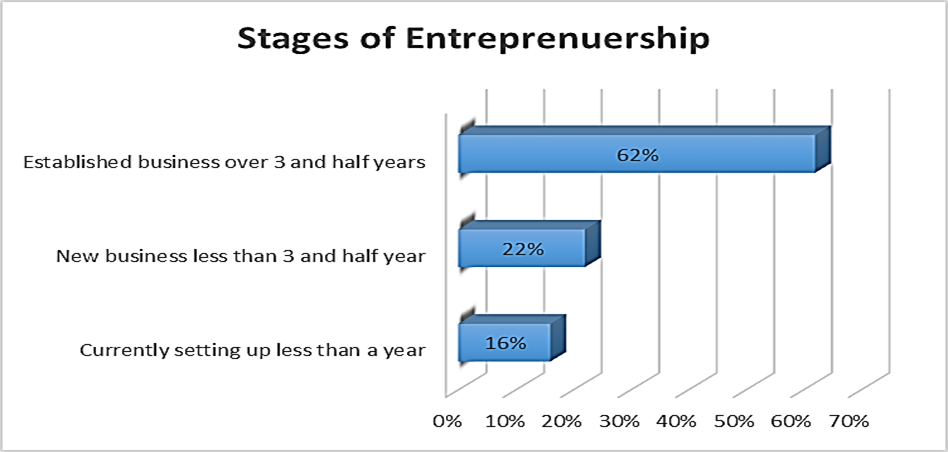 | Figure 4.6. Stage of Entrepreneurship |
 | Figure 4.7. Organizational Challenges |
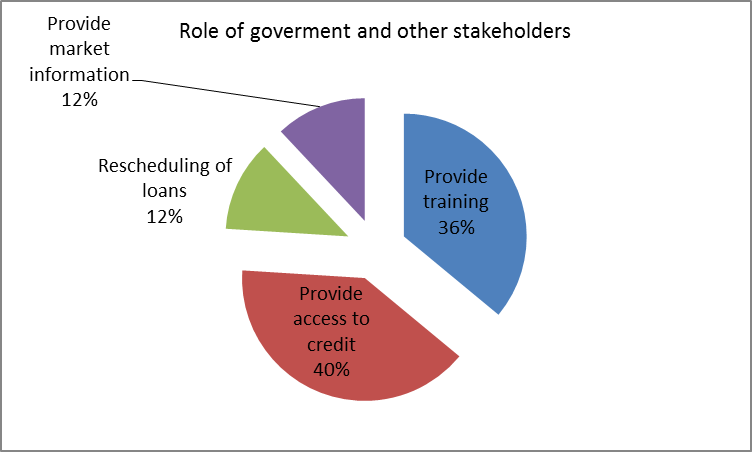 | Figure 4.8. The role of government and stakeholders |
5. Discussion and Conclusions
- The main aim of this study was to ascertain internal or organisational factors that hinder the growth entrepreneurs and also to establish whether their level of education has influence on their growth in the competitive business environment. A sample size of 150 was used to collect both quantitative and qualitative data from respondents.From the results it can be implied that more men are engaged in small scale business enterprise because of lack of employment opportunities and that men must feed the families back home or they risk engulfed in the cycle of poverty. In terms education most of the Education levelsMajority of the respondents had a minimum of secondary education whereas very few of them have attained college and university qualifications respectively which as adequate enough to manage a small business. In addition, the results have revealed that acquiring knowledge and skills through education improves the performance of the business. According to Nkoniki (2010), educated entrepreneurs could discharge their entrepreneurial activities effectively as they could take and manage risks more easily. Furthermore, a study by Sather (2012) on small scale aquaculture in rural Zambia revealed that lack of business knowledge posed a serious hindrance to sustainable growth for local entrepreneurs. Both studies indicated that lack of adequate and relevant education was one of the factors that hindered the growth of entrepreneurs. Internal Challenges faced by Entrepreneurs in their pursuit for growth.Literature suggests that entrepreneurs desire to grow but as they pass through each stage of growth cycle, they face a number of challenges (Dollinger, 2008). In support of the above assertions, the research observed that Solwezi based entrepreneurs faced the following challenges, among others, which hindered their growth. Inadequate Capital and Inaccessibility to Credit- The results of the research indicated that inadequate capital and inaccessibility to credit were the major challenges entrepreneurs were facing. Studies have shown that lack of access to capital is the major constraint to small business growth (Kuzilwa, 2005; Nkoniki, 2010). Entrepreneurs always find it difficult to access finance to expand their businesses because of credit restrictions and need for collateral among other numerous conditions. Mbungua et al (2013). Inappropriate Infrastructure is also another challenge facing entrepreneurs inadequate physical infrastructure had been acknowledged as a factor hampering business growth, especially production capacity (and market access), and sometimes leads to business failures (Boateng, 2011). Most entrepreneurs could not afford internal infrastructure such as computer technology or even where they had computers, they failed to continuously upgrade their equipment or systems (Dabson, 2001; Malecki; 2001). Furthermore, the study identified lack of Market Information and Connection as another challenge facing entrepreneurs. According to IFAD (2011), lack of market information (on commodity prices, suppliers and customers) leads to loss of income and exploitation of entrepreneurs by middlemen. The other factors identified include; Lack of Management Skills; Challenges of collecting debts and lack of appropriate skills. Wiklund et al (2007) argued that experience and skills of all employees was paramount to the firm’s growth. Similarly, the above findings are in line with Godfrey et al (2011) who revealed that poor design and implementation of internal controls such as segregation of functions of authorising, recording transactions and maintaining custody of certain types of assets would pose a challenge to organisation growth. With the majority of the businesses being run by the owners with secondary school education, it could be that these owners were not ‘professionally’ competent to implement most of the best practices of running businesses. Finally, as both the government and business houses are the major stakeholders in entrepreneurial growth, lack of consultation or collaboration affects entrepreneurial growth (Perren, 2000). He further suggested that there is a correlation between government support policies and entrepreneurial growth. Government policy in this context is any course of action which aims at regulating and improving the conditions of the entrepreneurs in terms of supportive, implementation and funding policies by the government. Therefore the study revealed that the government and other stakeholders have a number of roles to play such as providing access to credit, provide training and market information to entrepreneurs.
6. Conclusions
- In conclusion, a study of the entrepreneurs could provide some insight into the stage of development at which they were and whether their education level had an impact on their performance and subsequently pursuit for growth. In additional, such a research could help identify the challenges entrepreneurs faced, if any, and what other stakeholders could do to help mitigate such challenges.During the study of the Solwezi based entrepreneurs, it was discovered that though most of them had been operating for over three and half years, their level of development was still not very high as only half of them had ventured into some other businesses or products other than the initial ones. It was also observed that as much as many entrepreneurs strive to perform better, they experience some challenges which hinder growth due to inadequate capital, lack of infrastructure, market connection and some lack of appropriate skills. In additional, it can be concluded that most entrepreneurs do not grow as would be expected (from the number of year of existence) because their owners do not have a balance of adequate education and relevant experience. The underlining factor could be that lack of better education for these entrepreneurs has resulted into poor leadership, mismanagement of resources, lack of initiative, incompetence and missed opportunities to further develop their assets, such as skills and experience. Furthermore, as businesses were being run by either themselves or family members, this could be that these businesses were not being commercially run as most entrepreneurs and family members would not be professionally competent to run them.
7. Policy Implications
- In this research, key challenges facing entrepreneurs were investigated. Entrepreneurs/owner managers are facing challenges and their business performance is very poor.Policy makers would like to see how best they can provide support that can enhance the growth of small business in Zambia. Therefore, the results of this study will help entrepreneurs to appreciate factors hindering their growth and seek help to address them through the government and non-governmental organisations support.To the policy makers, the results of the study will help them to understand the failure factors for small businesses and the nature of the business environment they are operating in. This will provide the basis for policy formulation which will promote the growth of small businesses through the provision of loans at subsidized interest rates, reduced taxes, free or subsidized information and advice, ensuring smaller firms get shares of government contracts and so on and so forth.
 Abstract
Abstract Reference
Reference Full-Text PDF
Full-Text PDF Full-text HTML
Full-text HTML